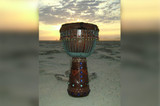How to Choose the Right Cymbals
As a drummer new to your instrument or perhaps ready to move beyond your starter kit, the choices for cymbals can get overwhelming. There are so many brands and styles to choose from, it's hard to know which models will best fit your musical style. While a standard drum kit will typically come with a ride cymbal and hi-hat, the other accent cymbals are left up to you to build into the kit. After reading this, you will be able to define your musical style and get pointed in the right direction for cymbals that deliver optimal tones for your style of play.
Our recommended cymbals for beginner players on a budget:
Meinl HCS New Player Cymbal Setup, Hi-Hat and Crash
Sabian B8 Cymbals
1. What is your style of play? Who are your drumming idols?
A great starting point for finding an optimal family of cymbals for your style of play is to research other drummers that inspire you and have the tones you're after. Make a list of these players and the cymbals they're using. If any of the players are endorsed by a major brand, that brand's website will typically have a player profile for him/her detailing their entire artist setup.
2. Research the cymbals in your list
Once you have your list, seek out videos of drummers playing them in a full set performance, or better yet... go see them play live. By seeing the cymbals in various settings, you'll learn the tonal differences between the various models and brands quickly and know which cymbals will best fit your setup.
3. Budget is a factor
With this strategy for finding the perfect cymbal, you might find yourself with a list of cymbals totaling $1,000.00 or more. So, at this point, before getting too attached to your dream cymbal, let’s look in the wallet and see what we have to work with.
If the cymbals on your list are outside of your budget, that's OK, we can work it out.
At this point, if you have narrowed down your picks to a specific brand and model, but they are out of your price range, take a look at the cymbal features and write them down.
Next, check out all of the cymbal collections for the specific Brand that you like and understand the hierarchy of the collections. For example, if you decided that you like the Sabian AA Ride Cymbal, you will see that collection is in the upper tier of their models. You’ll also see that Sabian offers a B8 Pro and a B8 Intro series collection where the brand is the same, but the price is much more affordable. So take the list of features from that Sabian AA Ride and see which of the less expensive models have similar features and start a new list of "affordable cymbals".
4. Sample the finalists
Now that you have two lists of options, start sampling audio and video performances of the cymbals on the web and learn as much as you can about the versatility of each model. If possible, as mentioned above, see a live performance of a drummer with the cymbals. You want to hear them played by different people in different scenes to really understand their range and give each one a fair chance.
5. Time to buy
At this point, you probably know which cymbal you want and you can make the purchase. If you are still stuck between a few models, call ahead to a local drum shop to make sure they have the cymbals you are considering and make an appointment to test them.
One warning about in-store testing: the environment for testing cymbals in a store can be quite unnatural as the cymbals are sometimes hung on the wall or you are put into a tiny room to ping it with a stick. This is why your research is so important and why you want to see your cymbal played in a full performance setting whenever possible.
And don't stress: A drummer can never have enough cymbals, so know that your choice today isn't permanent. As your performance demands change, you'll expand your cymbal collection to be more dynamic and increase your range.
Some basic tips for beginners:
- Learn the various terms associated with cymbals, so you can identify a washy sound as opposed to a trashy cymbal. Heavy cymbals deliver a bright response with an extended sustain. Light cymbals provide you with lighter sounds and less of a resonance.
- If you favor hard rock/metal music, you may be interested in heavy rides and crashes in large sizes. For jazz and contemporary music, you could choose medium weight cymbals like 16 inch rides with a few smaller Chinas thrown in.
- The weight and size of a cymbal will influence its sound quality, so brush up on the types of cymbals that are available and what they are made from. Sabian cymbals, for example, are made of bronze alloy and can be purchased in various weights. Sabian recommends starting out with a mid-weight cymbal so you can gauge the cymbal's response to your specific type of drumming. A cymbal with heavier weight has a more powerful response that the thin or light cymbals.
Recent Posts
-
What is the Best Size Djembe for Beginners?
If you're new to the world of percussion and interested in learning the djembe, you're in for a t …16th Jul 2024 -
The Benefits of Becoming a Drumming Teacher: Transforming Passion into Profession
Why become a drumming teacher? Becoming a drumming teacher is an excellent way to share your pas …22nd May 2024 -
What Makes the Djembe Drum a Spiritual Instrument in African Music?
Origin and history of the Djembe drum The Djembe drum originates from West Africa and holds sign …16th May 2024



